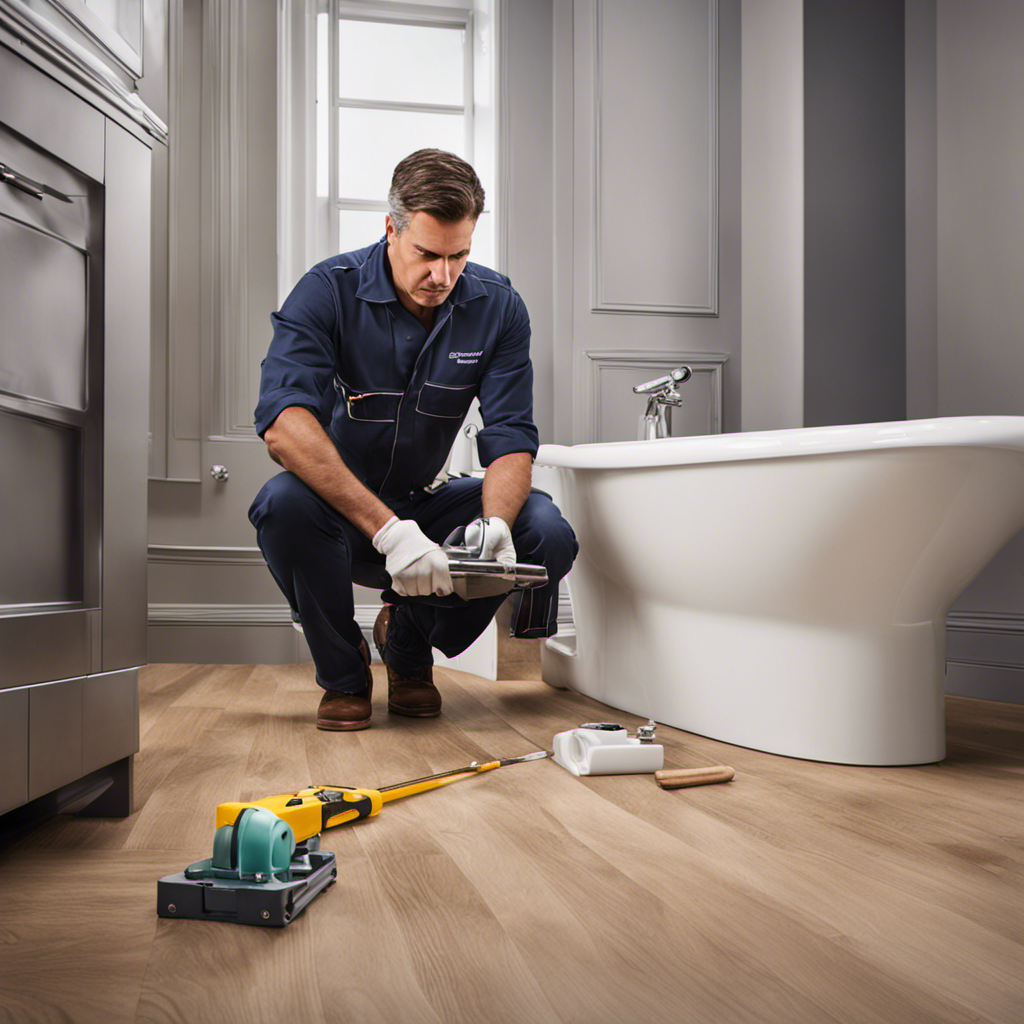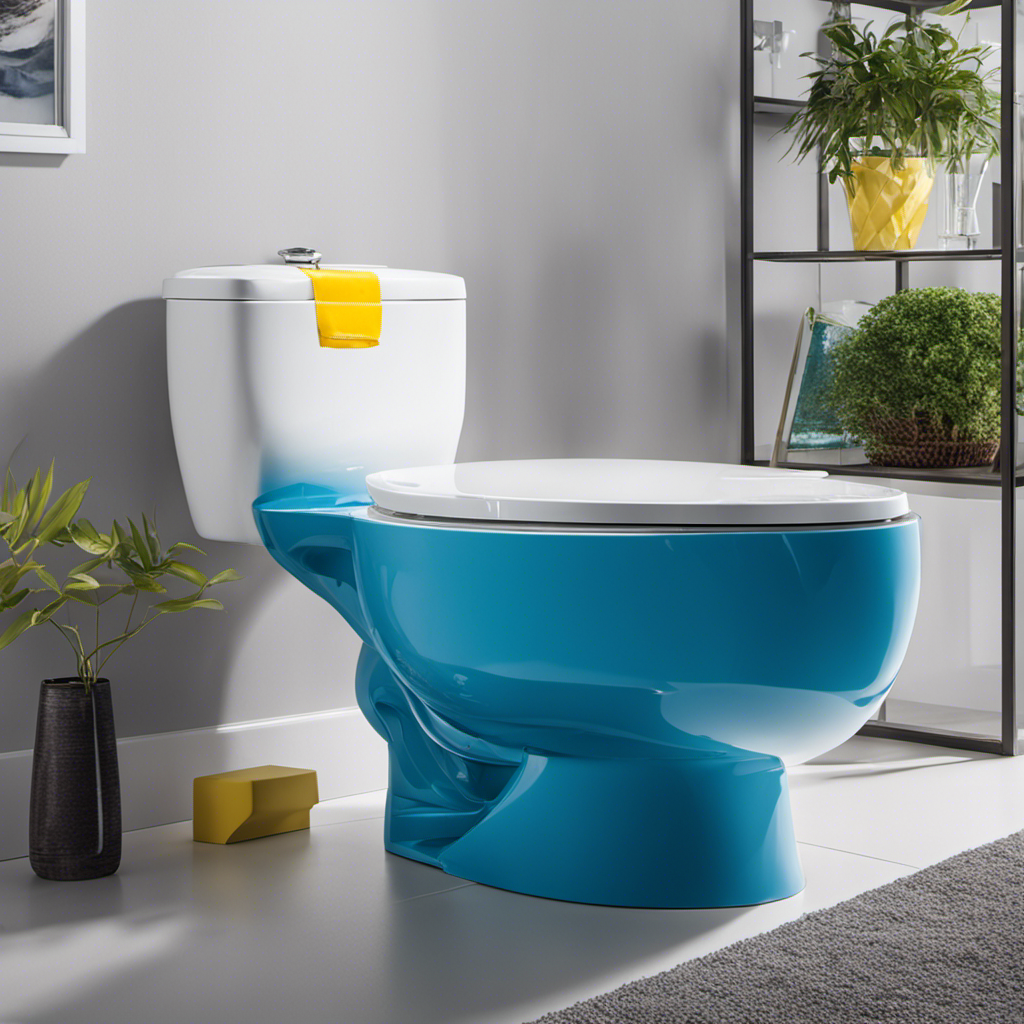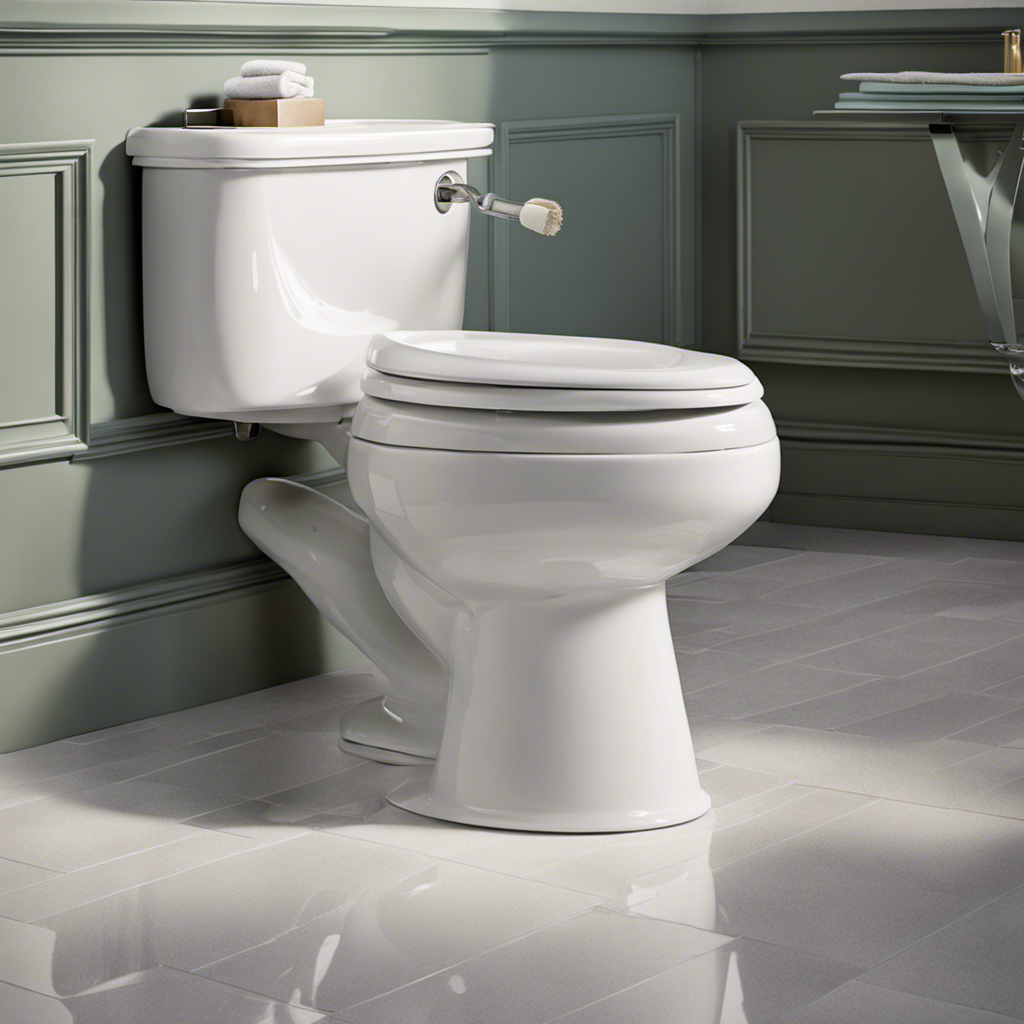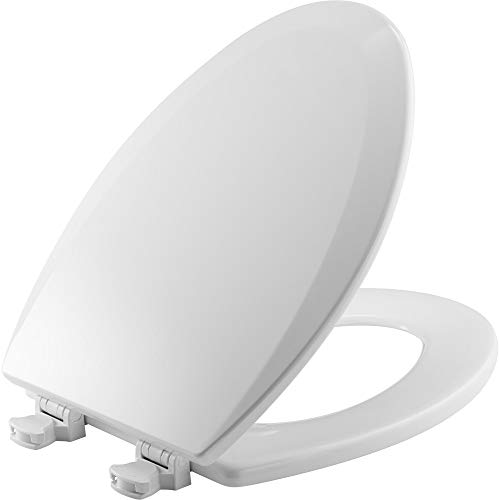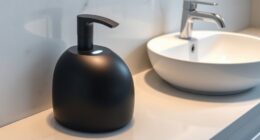Hey there!
Have you ever had the unpleasant experience of dealing with sticky poop in your toilet bowl? It’s not the most glamorous topic, but it’s something many of us have encountered.
Well, fear not! In this article, I’ll be sharing some valuable tips on how to prevent this sticky situation and maintain a clean toilet.
From addressing weak flush systems to using natural remedies and adjusting our eating habits, we’ll cover it all.
So, let’s dive in and say goodbye to sticky poop once and for all!
Key Takeaways
- Weak flush systems can cause poop to stick to the toilet bowl and should be identified and fixed promptly.
- Regular cleaning and maintenance of the toilet can prevent the accumulation of debris and stains that can lead to sticky poop.
- Eating a low-fat diet can help prevent poop from sticking to the toilet bowl.
- There are various prevention techniques, natural remedies, and proper flushing techniques that can be used to prevent sticky poop and maintain a clean toilet.
Weak Flush System
I’ve noticed that a weak flush system can cause poop to stick to the toilet bowl, which is a common issue that needs to be addressed.
Common causes of weak flush systems include a malfunctioning toilet flapper that closes too fast, as well as various other reasons.
Troubleshooting weak flush systems is crucial in preventing poop from sticking. One solution is to strengthen the flush system by ensuring sufficient water power to effectively remove debris.
Another important factor is regular cleaning to prevent the accumulation of debris and mineral deposits that can obstruct water flow and cause poop to stick.
Additionally, manufacturing defects such as folds and ridges on the toilet bowl can also be a cause, and valid warranties can be used to request a refund or replacement.
Identifying and fixing the cause of weak flush systems can ensure a clean and properly functioning toilet.
Irregular Toilet Cleaning
Regular cleaning helps prevent the buildup of debris and mineral deposits in the toilet bowl. It’s important to clean the toilet regularly to maintain hygiene and prevent sticky poop. Here are some key points to consider:
-
Toilet cleaning frequency: Cleaning the toilet at least once a week is recommended to remove accumulated debris and prevent the formation of mineral deposits.
-
Importance of removing mineral deposits: Mineral deposits, caused by hard water, can create ridges and stains in the toilet bowl. These ridges can trap poop, making it difficult to flush away and leading to sticky poop situations.
-
Using appropriate cleaning products: Using a toilet bowl cleaner specifically designed to remove mineral deposits can help effectively clean and prevent buildup.
-
Proper cleaning technique: It’s important to scrub the toilet bowl thoroughly, paying attention to areas where mineral deposits and debris tend to accumulate, such as under the rim and along the waterline.
Folds and Ridges on the Toilet Bowl
Identifying the cause of folds and ridges on the toilet bowl is crucial in preventing poop from sticking. Common causes of folds and ridges on the toilet bowl include manufacturing defects and malfunctioning toilets.
These folds and ridges create a rough surface that makes it easier for poop to stick. To fix this issue, it is important to first determine if the toilet bowl has any warranty coverage for manufacturing defects. If so, a refund or replacement can be requested.
If not, unclogging the toilet may be necessary to remove the stuck poop. Additionally, applying a non-stick coating or using a homemade toilet bowl cleaner can help smooth out the surface of the toilet bowl, making it more difficult for poop to stick in the future.
Eating Fat-Rich Food
Avoiding fatty foods can help reduce the stickiness of waste in the toilet bowl. Changing dietary habits by avoiding fat-rich foods has multiple benefits, including reducing the risk of sticky poop.
Consuming a fatty diet creates a greasy texture in poop, making it more likely to stick to the toilet bowl. This can lead to difficulties in flushing and increased cleaning efforts. Additionally, fatty diets have health risks associated with them, such as weight gain and increased cholesterol levels.
Prevention Techniques
Using proper flushing techniques and incorporating preventive measures can help maintain a clean and efficient toilet. Prevention techniques not only ensure a hygienic environment but also offer health benefits.
Regular cleaning using a toilet brush and applying a toilet bowl cleaner can prevent debris and stains from accumulating. Flushing with hot water helps to dislodge any stubborn residue. Natural remedies such as vinegar and baking soda, lemon juice, and essential oils can be effective in removing stains and preventing poop from sticking.
Proper flushing techniques, like flushing twice and using a high-pressure flush, ensure that waste is thoroughly removed. Changing eating habits by increasing fiber intake, drinking more water, and avoiding greasy foods can also contribute to a cleaner toilet and promote overall health.
Natural Remedies
My favorite natural remedy for preventing poop from sticking to the toilet bowl is using vinegar and baking soda. This homemade toilet bowl cleaner is not only effective but also environmentally friendly.
Here are the benefits of using natural remedies for toilet cleaning:
-
Safe for the environment: Unlike commercial cleaners that contain harsh chemicals, natural remedies are gentle on the environment.
-
Cost-effective: Vinegar and baking soda are affordable ingredients that can be found in most households.
-
Non-toxic: Natural remedies do not release harmful fumes, making them safer for you and your family.
-
Versatile: Vinegar and baking soda can be used for various cleaning purposes, not just for the toilet.
To make this homemade toilet bowl cleaner, simply mix equal parts of vinegar and baking soda to form a paste. Apply the paste to the toilet bowl, let it sit for a few minutes, and then scrub with a toilet brush. Rinse with water, and you’ll have a sparkling clean toilet without any sticky residue.
Proper Flushing Techniques
Flushing twice and holding the handle longer can improve the efficiency of the flush. These techniques optimize water pressure and ensure that the toilet bowl is thoroughly cleaned.
To achieve a stronger flush, you can also adjust the flapper. The flapper is the rubber valve at the bottom of the tank that controls the flow of water into the bowl. If the flapper closes too quickly, it can disrupt the flushing process.
Adjusting the chain connected to the flapper can help regulate its closing speed. By making small adjustments to the chain length, you can ensure that the flapper stays open longer, allowing for a more powerful flush.
Toilet Paper Techniques
Now, let’s discuss some toilet paper techniques that can help prevent sticky poop and keep your toilet clean. It’s important to note that reducing our reliance on toilet paper can also have a positive impact on the environment.
Here are some alternatives to consider:
-
Using less toilet paper: By using less toilet paper, you can reduce waste and minimize the chances of sticky poop sticking to the bowl.
-
Folding the toilet paper: Folding the toilet paper instead of wadding it up can provide better coverage and improve cleaning efficiency.
-
Using flushable wet wipes: Flushable wet wipes are an alternative to traditional toilet paper that can provide a more thorough cleaning experience.
-
Using a bidet: Bidets are becoming more popular as they provide a gentle water spray for cleaning, eliminating the need for toilet paper altogether.
Toilet Bowl Coatings
Applying a non-stick coating to the toilet bowl can help prevent residue from adhering to the surface, ensuring a cleaner and more hygienic bathroom experience.
There are different types of toilet bowl coatings available, each with varying levels of effectiveness and durability. Some popular options include ceramic glazes, silicone sprays, car wax, and homemade toilet bowl cleaners.
Ceramic glazes offer long-lasting protection and are resistant to stains and scratches. Silicone sprays provide a smooth and slippery surface, making it difficult for residue to stick. Car wax creates a protective barrier, repelling dirt and grime. Homemade toilet bowl cleaners, typically made from natural ingredients, can also be effective in preventing residue buildup.
It is important to choose a coating that suits your specific needs and preferences to ensure optimal results.
Frequently Asked Questions
Can a Weak Flush System Be Fixed Without Replacing the Entire Toilet?
Yes, a weak flush system can often be fixed without replacing the entire toilet. There are alternatives such as adjusting the water level, cleaning the flush holes, or replacing the flapper valve.
How Often Should I Clean My Toilet to Prevent Poop From Sticking?
To prevent poop from sticking, I clean my toilet weekly. Using a toilet bowl cleaner and a brush, I ensure thorough cleaning. Regular maintenance and using effective cleaning products are key to a clean toilet.
Are There Any Specific Signs or Symptoms That Indicate a Malfunctioning Flush System?
There are specific signs and symptoms that indicate a malfunctioning flush system. These can include weak flushing power, frequent clogs, water leaks, and unusual noises during flushing. It’s important to address these issues to prevent further problems.
Can a Weak Flush System Cause Other Plumbing Issues Besides Poop Sticking to the Bowl?
Yes, a weak flush system can cause other plumbing issues besides poop sticking to the bowl. For example, it may lead to clogged pipes, inefficient water usage, and increased risk of backups or overflows.
Are There Any Long-Term Health Effects of Consuming a Diet High in Fat-Rich Foods That Contribute to Sticky Poop?
There can be long-term consequences and health risks associated with consuming a diet high in fat-rich foods that contribute to sticky poop. It’s important to consider the impact on digestion and overall health.
Conclusion
In conclusion, it is essential to maintain a clean toilet and prevent sticky poop for a hygienic bathroom environment. There are several common causes that need to be addressed, including a weak flush system, irregular cleaning, folds and ridges on the toilet bowl, and consuming fat-rich foods. By effectively preventing poop from sticking, we can ensure a cleaner toilet.
Implementing prevention techniques is crucial. Regular cleaning is important, and natural remedies such as vinegar and baking soda can be used. Employing proper flushing and toilet paper techniques is also necessary. Additionally, considering toilet bowl coatings can contribute to a cleaner toilet.
Remember, a clean toilet is like a breath of fresh air in your bathroom sanctuary.

